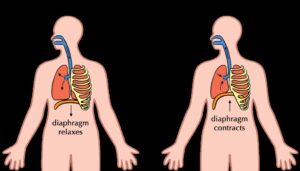Every breath you take
Your breathing patterns affect numerous functions in your body. At the same time, how your body functions can also affect your breathing patterns.
Several studies have been done to demonstrate how dysfunctional breathing patterns can affect postural stabilization, increased exhalation of CO2 which can elevate the body’s blood pH, as well as lead to various muscle imbalances. They can also cause muscle tension, reduced motor control, muscle spasms, and increased pain sensitization. Additionally, quick breathing affects body chemistry such as changes in magnesium, calcium, and potassium which can affect motor control mechanisms involved with core (muscles between the shoulders and the hips) function.
Common Signs of Dysfunctional Breathing
First thing is to determine whether you are breathing optimally. Some common signs of dysfunctional breathing include (but are not limited to):
- lifting your chest when you start a breath – when you inhale do you lift your chest first?
- not expanding your rib cage laterally (like inflating a balloon) – place your hands on your lower ribs, when you breathe does your trunk widen when you inhale? Ideally your hands should move apart from each other about 1 1/2 – 2 inches.
- mouth breathing (this is noticeable) – note if you breathe a lot from your mouth. This can also cause dehydration.
- elevating shoulders when inhaling – do your shoulders rise when you inhale (similar to lifting your chest)?
- frequent sighing – often a result of short quick breaths.
- breathing rate of 12 – 14 times per minute when at rest – how many breaths do you take per minute? It should take about 10 seconds to inhale and exhale, resulting in a resting breath rate of 6 – 8 breaths per minute. Most of us breathe at least 10 – 14 breaths per minute which is not optimal.
- check which moves first – place your right hand on your upper chest and your left hand on your lower abdomen. Which way does the hand on your chest move? It should move slightly forward and the abdomen should expand.
- forward head posture – also can be caused by tension which can be caused by dysfunctional breathing – a domino effect.
Good News
The good news is that you can retrain your breathing patterns to improve body function. Performing the following exercise regularly optimizes your breathing patterns overtime to the point where you don’t even think about it.
Nose breathe and count
First of all, practice breathing through your nose ALL OF THE TIME. Your nose has some level of filtering and also minimizes the loss of moisture.
Don’t think you can do it because you are stuffed up all of the time? Practice nose breathing anyway because it will help you breathe clearly over time!
Secondly, controlling how fast you breathe is one of the best ways to retrain your breathing pattern. This can be done by breathing in through the nose and out slowly through the nose (or alternatively, breathing out through pursed lips).
Try this:
- Sit up straight in a chair, chin slightly tucked such that the back of your head is inline with your spine.
- Inhale through your nose slowly to a count of 3 and pause for count of 2.
- Exhale through your nose or pursed lips (as if blowing a candle slowly so as not to blow it out) to a count of 5.
- Pause for count of 2 exhaled and repeat.
Try this exercise twice daily for 30 reps. It helps you breath slower, improves CO2 levels, and over time can improve overall body function.
NOTE:
- Shoulders should be level throughout the reps
- Breathe from the abdomen – place your hand on your stomach to feel your lower abdomen expanding.
- Chest should not rise.
- Control the speed of your inhale and exhale.
As usual, if you have questions, please contact me!




